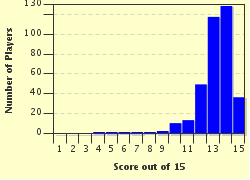Quiz Answer Key and Fun Facts
1. Your skeleton has many functions. Which one of these is NOT a function of the bones?
2. What is the name of the part in your body where two bones come together?
3. Joints have two types of connective tissues that hold it together. Which of these is one of them?
4. You have more bones when you are an adult than when you are a baby.
5. If you take a human bone out, the first layer (the top) is called the outer membrane. What is the layer under that called?
6. Where is the smallest bone in your body located?
7. What is the longest bone in your body called?
8. Exercising is a good way to help keep your bones healthy.
9. Older people lose some of the minerals that bones contain. Mineral loss can lead to what disease?
10. A break in the bone is also known by which word?
11. What is an injury in which the end of a bone comes out of its joint?
12. What injury occurs when ligaments are stretched too far and tear in some places?
13. X-rays, MRI, and CT scans are used to identify bone injuries.
14. Which one of these is a disease of the joints that makes movement painful?
15. Which instrument is used by doctors to see inside a joint during surgery?
Source: Author
foil7
This quiz was reviewed by FunTrivia editor
rossian before going online.
Any errors found in FunTrivia content are routinely corrected through our feedback system.


